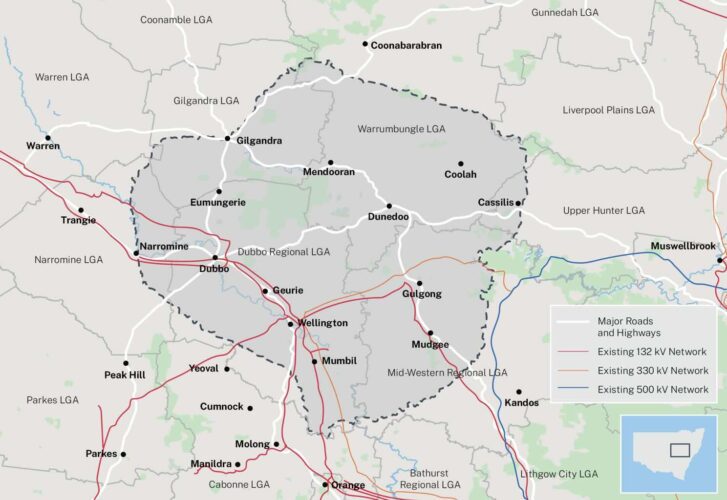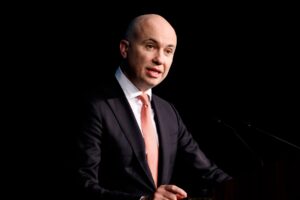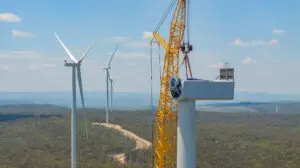The New South Wales government says it has finalised contracts for the construction of its first renewable energy zone, a key milestone for the state’s transition from coal to renewables, but the wind and solar industry is still waiting for news on who will have access to the grid.
State energy minister Penny Sharpe says work will commence “within months” on the Central West Orana renewable energy zone after the winning consortium to build the new transmission lines and other infrastructure reached financial close and signed the final contracts.
The CWO renewable zone is one at least five planned by the government as part of its infrastructure plan to replace the state’s ageing coal fired generators, three of which will close in less than a decade. The others are located in New England, the south west, the Hunter and the Illawarra.
The CWO zone – based around Dubbo and Dunedoo – will deliver 4.5 gigawatts of new network capacity by 2028, and will be able to connect 7.7 gigawatts of new wind and solar, plus storage, to the grid. The government says it will attract $20 billion of new investment by 2030, and create up to 5,000 jobs.
“Getting this deal done brings us closer to delivering more affordable and reliable renewable energy to NSW households and businesses,” Sharpe said in a statement on Friday.
“With three out of four of the state’s remaining coal-fired power stations set to close in less than 10 years, this Renewable Energy Zone will help us meet our future energy needs in order to keep the lights on and avoid price spikes.”

The CWO REZ will be built by a consortium made up of Acciona, Cobra, and Endeavour Energy after a tender was held to attract the most competitive bid. Transmission project costs around Australia – and the world – have been bedevilled by a blow out in costs, due to rises in equipment, labour and civil construction costs.
However, the REZ process has not been met with universal acclaim, with some local communities – particularly in the central west and New England zones – upset that they will have to support the bulk of new developments, although others in the south-west REZ wish they could accommodate more.
There is also frustration in the renewables industry itself about the central command and control nature of the scheme, with some choosing to build outside REZs.
Also, the owners of the local networks say they have tens of gigawatts of spare capacity on existing networks but have largely been ignored in the market operator’s planning blueprint, the Integrated System Plan.
The frustration is also extending to those that have bid for access rights to the zones, with the deals yet to be finalised.
The “expedited” process for allocating access rights for the CWO zone was begun early last year, with applications closing nearly a year ago, in late May, 2024. It is understood that winners have been notified, but not announced, pending the final negotiations with the network operator.
A similar issue is occurring in the south west zone, based around the new link to South Australia, Project Energy Connect. That zone has been limited to just 4 GW of new capacity, even though there are more than 20 GW of potential projects.
AEMO Services, which is conducting the tenders, chose the winning projects and advised them earlier this year, but they are yet to be ratified and announced by the state authority EnergyCo.
And there is also concern about the lack of co-ordination between state and federal tenders, with some winners of the federal government’s Capacity Investment Scheme – such as Windlab’s Junction Rivers wind and battery project – stymied by its reported inability to gain the right to connect to the grid.
Simon Corbell, the former ACT energy and climate minister who is now chair of the Victoria government’s newly established State Energy Commission, says co-ordination between state and federal schemes need to be improved.
“We’ve seen some misalignment of awarded CIS projects against state regulatory environments,” Corbell told the Clean Energy Investment Forum in Sydney on Thursday.
“So whether that’s, for example, projects being awarded CIS contacts but not getting access to the REZ in the state, that that seems really poor outcome – (you have) one government compromising the capacity of another government policy.
“So there are those types of issues that need to be addressed. Equally, we’re seeing things like CIS contracts being awarded and projects are not yet permitted. Now, obviously the Commonwealth’s taking a view around whether or not they can get whether that project is a good chance of being permitted.
“So I accept there’s probably a bit of risk that they might take into account there. But generally, I think if you want to speed execution, really, the Commonwealth should be …. favouring projects that are well advanced, or if not connected, if not, COVID. So there’s that sort of alignment that still needs to be addressed.”
Others are looking for work-arounds to boost the capacity of some of the REZs, to unlock some of the rich resources that are found within them and may be restricted by grid constraints.
Engie and Squadron Energy, for instance, has flagged the use of giant batteries to act as “virtual transmission” and boosts the carrying capacity of the REZs, while Engie’s Laura Caspari, in the latest episode of Renew Economy’s weekly Energy Insiders podcast, says local loads such as data centres could also help unlock otherwise stranded capacity.
Sharpe, meanwhile, notes that the contract for the CWO renewable zone is the first competitively sourced REZ transmission project in Australia, and it has been designed to provide incentives for early delivery and cost efficiency.
Early works on the project started in February, and construction is scheduled to start mid-year.
Other zones are focusing on maximising existing infrastructure, such as the Hunter Central Coast zone which is being upgraded by local network provider Ausgrid.
In an interview with last week’s episode of the Energy Insiders podcast, Ausgrid CEO Marc England said capacity could be installed on existing distributed networks (such as Ausgrid) for a fraction of the cost of new transmission and new REZs.
England says the distributed network operators are putting together their own “distributed ISP” that will outline that potential, and present it to AEMO and state and federal energy ministers later this year.
Renew Economy has reached out to EnergyCo for more news about the access rights for the CWO and South West REZs, but had not received a reply before publication of this story.








